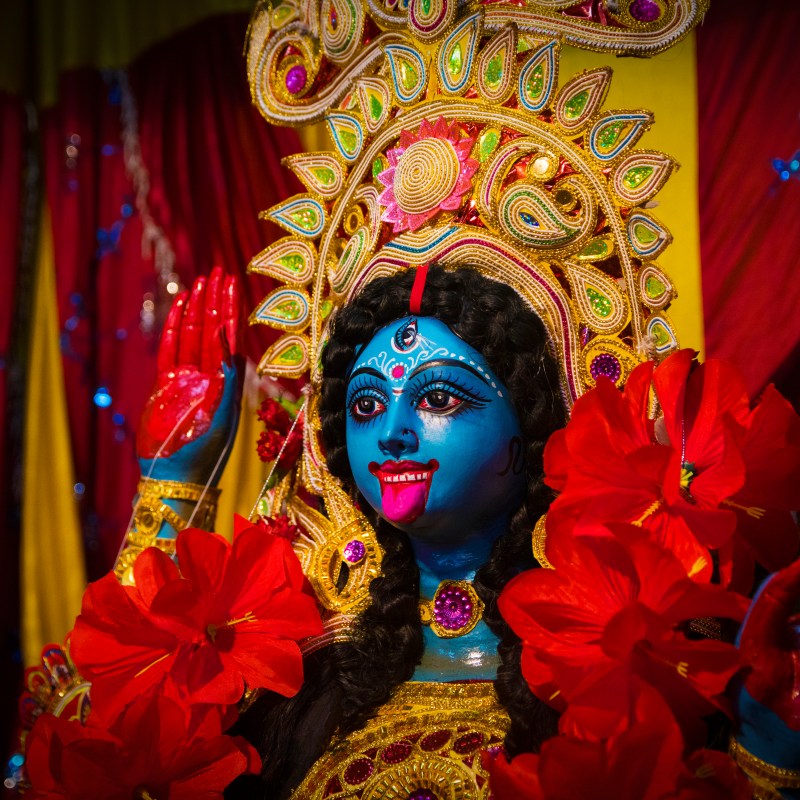
[The World Tour of Oopsies is an ongoing series of travel stories about my first decade of travel. During these adventures and misadventures, I unlearned many things I thought I knew about life. Welcome to my miseducation.]
Videos by TravelAwaits
Catch up on the World Tour of Oopsies travel stories:
Part I / Still at Kalighat Temple…
So far, my brief stint at the Kalighat Temple in Kolkata, India, had been an eventful one.
I’d witnessed my first animal sacrifice, followed by a well-earned slap after a domestic tourist was caught filming the act.
I barely had time to digest the experience, or even give one of those did you f*cking see that glances to one of my groupmates.
Instead, we were guided onward to the temple’s main structure. No talk about the goat. No talk about the slap.
This is probably a good time to remind you that Hinduism is incredibly complex and vast. Its temples reflect the religion’s intricacy and are structured according to many overlapping beliefs, practices, and traditions. (If you want to learn more, always focus on first-person Hindu sources.
In the case of the Kalighat Temple, the ‘sanctum sanctorum’, to borrow a Christian term, houses the idol, aka the murti in Hindi. This is where the idol dwells, usually inside a plain hall.
The goal is to focus all attention and worship on the deity, which resides inside the idol to be made ‘available’ to its worshippers. Hindus seek to connect to the murti because it’s a representation of a divine deity, putting them in semi-direct ‘contact’ with gods and goddesses. (I’ll dig into this more below.)
As our small group gathered near the temple’s innermost chamber, we were surrounded by worshippers ready to be closer to the murti. They were packing in, excited and eager.
Part II / The Murti
Here’s the catch: I hardly knew anything about murtis and their worship when I was standing inside the Kalighat Temple. Sure, I knew a thing or two about Kali Ma and was very excited to be at such an important temple, but that was about it.
Then I was being shuffled along to the temple’s innermost sanctum.
This is the ‘main event’ at many temples because it gives visitors the chance to be near the murti. The idol is the ‘medium’ through which they can understand, worship, and surrender to their deity. They might even touch the murti (with their right hand only) and, of course, make eye contact with it.
But hindsight is twenty-twenty, and my mind was a little coconut full of teenage wish-wash when I was led to the sanctum sanctorum of Kalighat Temple.
Another thing you should know about Hindu temples: they get busy, and people in India are handsy. (Touching is cultural.)
It’s not uncommon for a devotee or temple worker to stay in the sanctum sanctorum to keep the traffic moving by literally shoving people toward the exit. It might sound a little rough, but it’s to keep things moving.
After all, if you could bask in the presence of your god, wouldn’t you hang out for a while?
Part III / the Blessing
I remember filing into the room, uncertain of what I would see and what would happen next. This early on in my world tour, I wasn’t sure where to look, and I didn’t understand what would happen.
On top of that, I was squished between many bodies that seemed to come closer and move faster.
Then I saw the murti of Kali Ma to my left. (You can see an image of the actual murti at Kalighat Temple here.)
She sits adorned with layers of jewelry, flower garlands, and similar signs of devotion. The murti has three eyes (that includes the third eye, a sign of cosmic vision) and a massive, golden tongue. As with other depictions of Kali Ma, the goddess has black skin and, in this case, red eyes.
If you were paying close attention during Chapter Three: The Goat Sacrifice, you might remember that Kali Ma is fierce. (I think a good example is a mother’s love—a mother would kill for her child, and almost nobody would find that especially controversial because it is a mother’s role to defend her child with great ferocity.)
So, I figured a temple dedicated to Kali would include a memorable sight, but I didn’t realize how jarring it would be.
Making eye contact with the Kali Ma murti was a shock to the system.
I remember feeling physically jolted, a chill running up my spine. In the next second, a devotee standing beside the murti reached out to give me a blessing in the form of a bindi, which is a small mark on the forehead.
I didn’t know that was coming, either, so it felt like another jolt. (You might remember from Chapter 2 that I wasn’t overly familiar with human touch at the time.)
Then the small crowd’s momentum ferried me out of the sanctum sanctorum and back into the temple’s interior courtyard.
We left the temple shortly after, and when I returned home a month later, I didn’t really talk about the experience. I didn’t even journal about it.
Not because it didn’t have a profound effect on me, but because I knew that I didn’t have the knowledge or understanding to talk about the visit to Kalighat Temple correctly.
Maybe I’ve done better now, more than ten years on, but I still have my doubts.
